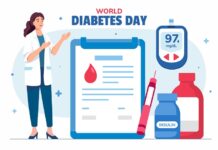Abstract
The escalating global burden of cardiovascular diseases (CVDs) is worrisome. The editorial emphasizes the critical role of individualized cardiovascular risk management, addressing controversies in cholesterol management and recognizing ethnicity-specific risk factors particularly considering genetic variations in Asian populations. It also delves into, creating awareness of hypertension and prevalent CVD including Ischaemic heart disease (IHD) and Heart failure (HF), their prevalence, and shifts in current management to tackle them. World Heart Day 2023, themed “Use Heart, Know Heart”, emphasizes the significance of knowing our heart and heart health for a healthy life.
Keywords: Cardiovascular Diseases, Hypertension, Ischemic Heart Disease, Heart Failure.
Conflict of Interest: Aristo Pharmaceuticals Private Limited, India
Source of Support: None declared
Introduction
CVDs, stemming from socio-economic, metabolic, behavioral, and environmental factors, persist as the foremost global cause of mortality. In 2021, 20.5 million deaths were attributed to CVDs, constituting nearly one-third of global fatalities a stark rise from 1990 figures. Mitigating CVD risks, including high blood pressure, unhealthy diet, and tobacco use, is paramount. Although 80% of premature heart attacks and strokes are preventable, equitable access to diagnostic and therapeutic tools remains deficient, disproportionately affecting low- and middle-income countries where 4 in 5 CVD deaths occur [1].
The global burden of CVDs is escalating, notably in Southeast Asia where it constitutes a significant proportion of cardiac-related deaths. South Asians in the United States (SAUS), include a heterogeneous group of individuals who trace their ancestry to the Indian subcontinent (India, Pakistan, Bangladesh, Sri Lanka, Maldives, Bhutan, and Nepal) and exhibit distinctive lifestyle and dietary patterns. Paradoxically, SAUS faces a disproportionately elevated burden of atherosclerotic cardiovascular disease (ASCVD) which occurs prematurely (<50 years) and presents aggressively.
Managing cardiovascular risk factors is pivotal in cardiology, but controversy exists over cholesterol management. The 2013 American College of Cardiology (ACC) /American Heart Association (AHA) Guideline on the treatment of blood cholesterol to reduce atherosclerotic cardiovascular risk in adults emphasizes a statin-centric approach, dismissing LDL (low-density lipoproteins) goals, while Europeans focus on LDL-centric strategies. In daily practice, individualization is key, considering patient characteristics. Risk prediction models from Western populations may lack precision in Asians due to genetic variations. Concerns persist regarding potential high-dose statin intolerance in Asians, necessitating personalized approaches for optimal cardiovascular risk management.[2]
As per the current risk calculators, AHA/ACC pooled cohort equations now recognize South Asian (SA) ethnicity as a risk-enhancer, reflecting a more accurate approach toward statin therapy initiation.[3]This editorial focuses on creating awareness towards a shift in management approach for various CVDs based on characterization. While considering risk factors in Indian patients differ from their Western counterparts for a better heart health. World Heart Federation (WHF) and AHA have chosen “Use Heart, Know Heart” as the theme for World Heart Day 2023, emphasizing the significance of knowing our heart and heart health for a healthy life.
1President- Medical and Regulatory Affairs, Aristo Pharmaceuticals Private Limited, Mumbai, India
Corresponding author: Dr. Manish Maladkar,President- Medical and Regulatory Affairs, Aristo Pharmaceuticals Private Limited, Mumbai, India Email:scientific@aristopharma.co.in
Hypertension: No More a Silent Killer
According to the Global Burden of Disease Study, high blood pressure (BP)is the leading modifiable risk factor globally. According to the World Health Organisation (WHO), approximately 1.13 billion people worldwide have hypertension which contributes to 10.8 million CVD deaths worldwide. It is estimated that 17.6% of hypertensive patients worldwide live in India, implying a significant increase in the burden of CVDs in the near future.[4] It is found that awareness, treatment and control of high BP among young adults with hypertension is very low. A community-based survey of the Indian population found that younger adults had less awareness of hypertension and its management than older population.[5]
The accurate measurement of BP is essential for the diagnosis and management of hypertension. Errors in the measurement of BP can lead to an incorrect diagnosis of hypertension. A 5mmHg error in BP measurement is estimated to result in the incorrect classification of hypertension status in at least 84 million people worldwide.[6]Errors in BP measurement are a major source of BP misclassification and therefore the 2017 ACC/AHA and 2018 European Society of Cardiology (ESC)/European Society of Hypertension (ESH) clinical practice guidelines for management of high blood pressure in adults, place strong emphasis on accurate measurement of BP by using validated devices and multiple readings for diagnosis and management of hypertension.[7]
Table 1: Recommendations for Office Blood Pressure Measurement [8]

*BP ≥140/90 is as per ESC/ESH 2018 guidelines and Indian Guidelines of Hypertension IV 2019 BP ≥130/80 is as per the ACC/AHA 2017 guidelines.
Telemedicine for remote BP monitoring can be implemented regionally, facilitating timely healthcare intervention without clinic visits. Healthcare providers may adjust antihypertensive medications through open communication, enabling titration over the phone. Also, Ambulatory and home monitoring can be utilized to assess treatment responses and aid in diagnosing white coat and masked hypertension. First-line antihypertensive medications include renin-angiotensin system blockers, long-acting calcium channel blockers, and thiazide diuretics. Persistent hypertension, despite maximal doses of these 3 agents, defines resistant hypertension. Spironolactone and eplerenone, mineralocorticoid receptor antagonists(MRA), constitute evidence-based fourth-line therapy. Refractory hypertension, uncontrolled despite ≥5 antihypertensive classes, may require additional agentslike β-blocker. [9]
Ischemic Heart Disease-From Silence to Catastrophe
IHD is now the leading cause of premature death in 146 countries for men and 98 countries for women.[1]Adults with a history of hypertension have an increased risk of acute Myocardial Infarction (MI).[3] MI may be “silent” and go undetected, or it could be a catastrophic event leading to hemodynamic deterioration and sudden death.
Statins remain central when considering pharmacotherapy given the causal relationship between lipid profile and ASCVD, though a variety of adjunctive lipid-lowering therapies are also available. In the setting of acute MI, PCI [percutaneous coronary intervention], when performed in a timely fashion, results in improved survival. This is especially important in patients presenting with acute ST-segment elevation myocardial infarction (STEMI), where every ten-minute delay in door-to-reperfusion translates to an 8% increase in in-hospital mortality.
Rapid restoration of brisk flow in the coronary vasculature is critical in reducing mortality and morbidity. In patients with STEMI who could not receive PCI on time, a pharmaco invasive strategy (thrombolysis followed by timely PCI within 3-24 h of its initiation) is an effective option.[10]
Heart failure- Symphony of Breaking Beats
HF, with its diverse phenotypes, demands tailored therapeutic approaches, with recent breakthroughs introducing novel agents and refining existing treatment paradigms, notably in HFpEF (HF with preserved ejection fraction) management.
The cornerstone of pharmacotherapy for HFrEF (heart failure with reduced ejection fraction, HFrEF); involves modulating the Renin-Angiotensin-Aldosterone System (RAAS), the Sympathetic Nervous System (SNS), and the natriuretic peptide system. Agents such as ACE inhibitors, Angiotensin Receptor-Neprilysin Inhibitor (ARNI), β-blockers, and MRAs, including eplerenone, potassium canrenoate, and spironolactone, have demonstrated mortality reduction and cardiovascular benefits. ARNI, combining valsartan and sacubitril, exhibits superior efficacy in reducing cardiac deaths and heart failure-related hospitalizations. A novel drug class, sodium-glucose co-transporter 2 (SGLT2) inhibitors like dapagliflozin and empagliflozin, initially approved for type 2 diabetes, now garners authorization for HFrEF treatment independent of diabetes. Emerging agents omecamtiv mecarbil, a positive inotropic agent, and vericiguat, initially for chronic thromboembolic pulmonary hypertension, demonstrate promising results in HFrEF treatment, signifying a dynamic landscape of therapeutic advancements in heart failure management.[11]
While the overall incidence of HF remains stable or declines, HFpEF is on the rise, constituting over 50% of cases. Recent advances in understanding HFpEF’s pathophysiology, diagnostic methods, and prognostic markers have ushered in innovative management approaches. Management of HFpEF focuses on:
- Risk stratification and management of comorbidities,
- Non-pharmacological management, including the role of exercise and weight loss and the use of wireless, implantable pulmonary artery monitors;
- Symptomatic management and disease-modifying therapy with loop diuretic agents, SGLT2is, MRAs, ARNIs, and angiotensin receptor blockers (ARBs).[12]
Conclusion
The prevalence, morbidity, and mortality due to CVDs are escalating globally despite the diagnostic and management approaches in place; this calls for transformation and advancement in present strategies for the management of CVDs based on individualized cardiovascular risk management, considering genetic variations in Asian populations and use of innovative therapies and novel drugs. The shift towards a dynamic and personalized approach to cardiovascular health is paramount. Acknowledging evolving therapeutic landscapes and emphasizing multifaceted strategies for risk reduction and disease management takes us one step closer to improving and managing CVD and heart health with each passing day.
References
- World heart report 2023 [Internet]. [cited 2023 Oct 4]. Available from: https://heartreport23.world-heart-federation.org/
- Loh JP, Poh KK. Changes in the practice of cardiology: therapies at the forefront of science. Singapore medical journal. 2016 Jul;57(7):344.
- Kulkarni A, Mancini GJ, Deedwania PC, Patel J. South Asian cardiovascular health: lessons learned from the national lipid association scientific statement. J Am Coll Cardiol. 2021:2021.
- Ramakrishanan S, Gupta K. Prevalence of hypertension among Indian adults: results from the great India blood pressure survey. Indian heart journal. 2020 May;72(3):217.
- Geevar Z, Krishnan MN, Venugopal K, Sanjay G, Harikrishnan S, Mohanan PP, Mini GK, Thankappan KR. Prevalence, awareness, treatment, and control of hypertension in young adults (20–39 Years) in Kerala, South India. Frontiers in cardiovascular medicine. 2022 Apr 18;9:765442.
- PadwalR,et al. Optimizing observer performance of clinic blood pressure measurement: A position statement fromthe Lancet Commission on Hypertension Group. J. Hypertens.2019 Sep;37(9):1737-1745.doi: 10.1097/ HJH.0000000000002112
- WheltonPK,et al. Harmonization of the American College of Cardiology/American Heart Association and European Society of Cardiology/European Society of Hypertension Blood Pressure/Hypertension Guidelines. Eur. Heart J.2022 Sep 14;43(35):3302-3311.doi: 10.1093/eurheartj/ehac432
- UngerT,et al. 2020 International Society of Hypertension Global Hypertension Practice Guidelines. Hypertension 75.2020 Jun;75(6):1334-1357.
- German CA,et al.. Defining preventive cardiology: A clinical practice statement from the American Society for Preventive Cardiology. American Journal of Preventive Cardiology. 2022 Nov 16:100432.
- Sethi R,et al. Feasibility and efficacy of delayed pharmacoinvasive therapy for ST-elevation myocardial infarction. World J Cardiol. 2023 Jan 26;15(1):23-32.
- Mascolo A, et al. Current and future therapeutic perspective in chronic heart failure. Pharmacological Research. 2022 Jan 1;175:106035.
- Kittleson MM, et al. 2023 ACC Expert Consensus Decision Pathway on Management of Heart Failure With Preserved Ejection Fraction: A Report of the American College of Cardiology Solution Set Oversight Committee. Journal of the American College of Cardiology. 2023 May 9;81(18):1835-78.
























